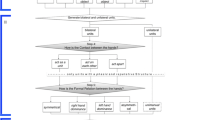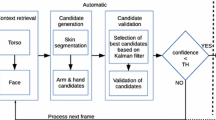Abstract
Gestures are commonly used together with spoken language in human communication. One major limitation of gesture investigations in the existing literature lies in the fact that the coding of forms and functions of gestures has not been clearly differentiated. This paper first described a recently developed Database of Speech and GEsture based on independent annotation of gesture forms and functions among 119 neurologically unimpaired right-handed native speakers of Cantonese (divided into three age and two education levels), and presented findings of an investigation examining how gesture use was related to age and linguistic performance. Consideration of these two factors, for which normative data are currently very limited or lacking in the literature, is relevant and necessary when one evaluates gesture employment among individuals with and without language impairment. Three speech tasks, including monologue of a personally important event, sequential description, and story-telling, were used for elicitation. The EUDICO Linguistic ANnotator software was used to independently annotate each participant’s linguistic information of the transcript, forms of gestures used, and the function for each gesture. About one-third of the subjects did not use any co-verbal gestures. While the majority of gestures were non-content-carrying, which functioned mainly for reinforcing speech intonation or controlling speech flow, the content-carrying ones were used to enhance speech content. Furthermore, individuals who are younger or linguistically more proficient tended to use fewer gestures, suggesting that normal speakers gesture differently as a function of age and linguistic performance.
Similar content being viewed by others
References
Ahlsén, E. (2011). Towards an integrated view of gestures related to speech. In Proceedings of the 3rd Nordic symposium on multimodal communication, Vol. 15, pp. 72–77.
Alibali, M. W., & DiRusso, A. A. (1999). The function of gesture in learning to count: More than keeping track. Cognitive Development, 14(1), 37–56.
Alibali, M. W., Kita, S., & Young, A. J. (2000). Gesture and the process of speech production: We think, therefore we gesture. Language & Cognitive Processes, 15(6), 593–613.
Anastasiou, D. (2012). A speech and gesture spatial corpus in assisted living. In Proceedings of the eight international conference on language resources and evaluation (LREC’12), Vol. 8, pp. 2351–2354.
Beattie, G., & Shovelton, H. (1999). Mapping the range of information contained in the iconic hand gestures that accompany spontaneous speech. Journal of Language and Social Psychology, 18(4), 438–462.
Beattie, G., & Shovelton, H. (2000). Iconic hand gestures and the predictability of words in context in spontaneous speech. British Journal of Psychology, 91(4), 473.
Box, G. E. P., & Cox, D. R. (1964). An analysis of transformation. Journal of Royal Statistical Society (Series B), 26, 211–246.
Bressem, J. (2008). Notating gestures: Proposal for a form based notation system of coverbal gestures. Unpublished manuscript.
Brugman, H., & Russel, A. (2004). Annotating multi-media/multi-modal resources with ELAN. LREC.
Butterworth, B., & Hadar, U. (1989). Gesture, speech, and computational stages: A reply to McNeill. Psychological Review, 96(1), 168–174.
Cohen, R. L., & Borsoi, D. (1996). The role of gestures in description-communication: A cross-sectional study of aging. Journal of Nonverbal Behavior, 20(1), 45–63.
Colletta, J. M., Pellenq, C., & Guidetti, M. (2010). Age-related changes in co-speech gesture and narrative: Evidence from French children and adults. Speech Communication, 52(6), 565–576.
Crowder, E. M. (1996). Gestures at work in sense-making science talk. The Journal of the Learning Sciences, 5(3), 173–208.
Dadgostar, F., Barczak, A. L. C., & Sarrafzadeh, A. (2005). A color hand gesture database for evaluating and improving algorithms on hand gesture and posture recognition. Research Letters in the Information and Mathematical Sciences, 7, 127–134.
Ekman, P., & Friesen, W. V. (1969). The repertoire of nonverbal behavior: Categories, origins, usage, and coding. Semiotica, 1(1), 49–98.
Feyereisen, P., & Havard, I. (1999). Mental imagery and production of hand gestures while speaking in younger and older adults. Journal of Nonverbal Behavior, 23(2), 153–171.
Field, A. P. (2009). Discovering statistics using SPSS: (and sex and drugs and rock ‘n’ roll) (3rd ed.). London: SAGE.
German, D. J. (2001). It’s on the tip of my tongue: Word-finding strategies to remember names and words you often forget. Chicago, IL: Word Finding Materials Inc.
Goldin-Meadow, S. (1999). The role of gesture in communication and thinking. Trends in Cognitive Sciences, 3(11), 419–429.
Goldin-Meadow, S. (2003). Hearing gesture: How our hands help us think. Cambridge, MA: Belknap Press of Harvard University Press.
Gooch, C. M., Stern, Y., & Rakitin, B. C. (2009). Evidence for age-related changes to temporal attention and memory from the choice time production task. Aging, Neuropsychology & Cognition, 16(3), 285–310.
Hayamizu, S., Nagaya, S., Watanuki, K., Nakazawa, M., Nobe, S., & Yoshimura, T. (1999). A multimodal database of gestures and speech. In Proceeding of the sixth European conference on speech communication and technology, Vol. 6, pp, 2247–2250.
Herrmann, M., Reichle, T., Lucius-Hoene, G., Wallesch, C. W., & Johannsen-Horbach, H. (1988). Nonverbal communication as a compensation strategy for severely nonfluent aphasic? A quantitative approach. Brain and Language, 13, 41–54.
Hostetter, A. B., & Alibali, M. W. (2007). Raise your hand if you’re spatial: Relations between verbal and spatial skills and gesture production. Gesture, 7, 73–95.
Hwang, B. W., Kim, S. M., & Lee, S. W. (2006). A full-body gesture database for automatic gesture recognition. In Proceeding of the 7th international conference on automatic face and gesture recognition, Vol. 7, pp. 243–248.
Jacobs, N., & Garnham, A. (2007). The role of conversational hand gestures in a narrative task. Journal of Memory and Language, 56(2), 291–303.
Just, A., Rodriguez, Y., & Marcel, S. (1996). Hand posture classification and recognition using the modified census transform. In Proceeding of the IEEE international conference on automatic face and gesture recognition, Vol. 2, pp. 351–356.
Kong, A. P. H., Law, S. P., Kwan, C., Lai, C., Lam, V., & Lee, A. (2012, November). A comprehensive framework to analyze co-verbal gestures during discourse production. Poster presented at the 2012 American speech-language-hearing association (ASHA) convention, Atlanta, GA, USA.
Kong, A. P. H., Law, S. P., & Lee, A. S. Y. (2010). An investigation of use of non-verbal behaviors among individuals with aphasia in Hong Kong: Preliminary data. Procedia Social and Behavioral Sciences, 6, 57–58.
Krauss, R. M., Chen, Y., & Gottesman, R. F. (2000). Lexical gestures and lexical access: A process model. In D. McNeill (Ed.), Language and gesture (pp. 261–283). Cambridge: Cambridge University Press.
Krauss, R. M., & Hadar, U. (1999). The role of speech-related arm/hand gestures in word retrieval. In R. Campbell & L. Messing (Eds.), Gesture, speech, and sign (pp. 93–116). Oxford: Oxford University Press.
Lanyon, L., & Rose, M. L. (2009). Do the hands have it? The facilitation effects of arm and hand gesture on word retrieval in aphasia. Aphasiology, 23(7–8), 809–822.
Lausberg, H., & Sloetjes, H. (2008). Gesture coding with the NGCS–ELAN system. In. A. J. Spink, M. R. Ballintijn, N. D. Bogers, F. Grieco, L. W. S. Loijens, L. P. J. J. Noldus, G. Smit, & P. H. Zimmerman (Eds.), Proceedings of measuring behavior 2008 (pp. 176–177). Netherlands: Noldus Information Technology.
Lausberg, H., & Sloetjes, H. (2009). Coding gestural behavior with the NEUROGES-ELAN system. Behavior Research Methods, 41(3), 841–849.
Le May, A., David, R., & Thomas, A. P. (1988). The use of spontaneous gesture by aphasic patients. Aphasiology, 2(2), 137–145.
Lücking, A., Bergmann, K., Hahn, F., Kopp, S., & Rieser, H. (2010). The Bielefeld speech and gesture alignment corpus (SaGA). In M. Kipp, J. P. Martin, P. Paggio, & D. Heylen, (Eds). LREC 2010 workshop: Multimodal corpora–advances in capturing, coding and analyzing multimodality (pp. 92–98). Republic of Malta.
MacWhinney, B. (2003). Child language analyses (CLAN) (version 23 September 2003) [Computer software]. Pittsburgh, PA: Author.
MacWhinney, B., Fromm, D., Forbes, M., & Holland, A. (2011). AphasiaBank: Methods for studying discourse. Aphasiology, 25, 1286–1307.
Marcel, S., Bernier, O., Viallet, J-E., & Collobert, D. (2000). Hand gesture recognition using input/ouput hidden markov models. In Proceedings of the 4th international conference on automatic face and gesture recognition, Vol. 4, pp. 398–402.
Mather, S. M. (2005). Ethnographic research on the use of visually based regulators for teachers and interpreters. In M. Metzger & E. Fleetwood (Eds.), Attitudes, innuendo, and regulators (pp. 136–161). Washington, DC: Gallaudet University Press.
Max Planck Institute. (2001, February 27). Gesture database (GDB). Retrieved from http://www.mpi.nl/ISLE/overview/Overview_GDB.html/.
Max Planck Institute for Psycholinguistics. (2002). http://www.lat-mpi.eu/tools/elan/.
Mayberry, R. I., & Jaques, J. (2000). Gesture production during stuttered speech: Insights into the nature of gesture-speech integration. In D. McNeill (Ed.), Language and gesture (pp. 199–214). New York: Cambridge University Press.
McNeill, D. (1992). Hand and mind: What gestures reveal about thought. Chicago: University of Chicago Press.
Montepare, J., Koff, E., Zaitchik, D., & Albert, M. (1999). The use of body movements and gestures as cues to emotions in younger and older adults. Journal of Nonverbal Behavior, 23, 133–152.
Montepare, J. M., & Tucker, J. S. (1999). Aging and nonverbal behavior: Current perspectives and future directions. Journal of Nonverbal Behavior, 23, 105–109.
Old, S. R., & Naveh-Benjamin, M. (2008). Differential effects of age on item and associative measures of memory: A meta-analysis. Psychology and Aging, 23(1), 104–118.
Osborne, J. W. (2010). Improving your data transformations: Applying the Box-Cox transformation. Practical Assessment, Research & Evaluation, 15(12), 1–9.
Quek, F., McNeill, D., Bryll, R., Duncan, S., Ma, X. F., Kirbas, C., et al. (2002). Multimodal human discourse: Gesture and speech. ACM Transactions on Computer-Human Interaction, 9(3), 171–193.
Rauscher, F. H., Krauss, R. M., & Chen, Y. (1996). Gesture, speech, and lexical access: The role of lexical movements in speech production. Psychological Science, 7(4), 226–231.
Ska, B., & Nespoulous, J. (1987). Pantomimes and aging. Journal of Clinical and Experimental Neuropsychology, 9, 754–766.
Smith, L. (1987). Nonverbal competency in aphasic stroke patients’ conversation. Aphasiology, 1(2), 127–139.
Triesch, J., & von der Malsburg, C. (1996). Robust classification of hand postures against complex backgrounds. In Proceedings of the second international conference on automatic face and gesture recognition, Vol. 2, pp. 170–175.
Wilson, F. R. (1998). The hand: How its use shapes the brain, language, and human culture. New York: Pantheon Books.
Wu, Y. C., & Coulson, S. (2007). How iconic gestures enhance communication: An ERP study. Brain and Language, 101, 234–245.
Xu, J., Gannon, P. J., Emmorey, K., Jason, F. S., & Braun, A. R. (2009). Symbolic gestures and spoken language are processed by a common neural system. Proceedings of the National Academy of Sciences of the United States of America, 106(49), 20664–20669.
Acknowledgments
This study is supported by the grant “Towards a multi-modal and multi-level analysis of Chinese aphasic discourse” (1-R01-DC010398) funded by the National Institutes of Health to Kong, A.P.H. (PI), Law, S.P. (Co-I), and Lee, A. (Co-I). The authors would like to thank all subjects for their help and co-operation during data collection.
Author information
Authors and Affiliations
Corresponding author
Rights and permissions
About this article
Cite this article
Kong, A.PH., Law, SP., Kwan, C.CY. et al. A Coding System with Independent Annotations of Gesture Forms and Functions During Verbal Communication: Development of a Database of Speech and GEsture (DoSaGE). J Nonverbal Behav 39, 93–111 (2015). https://doi.org/10.1007/s10919-014-0200-6
Published:
Issue Date:
DOI: https://doi.org/10.1007/s10919-014-0200-6




